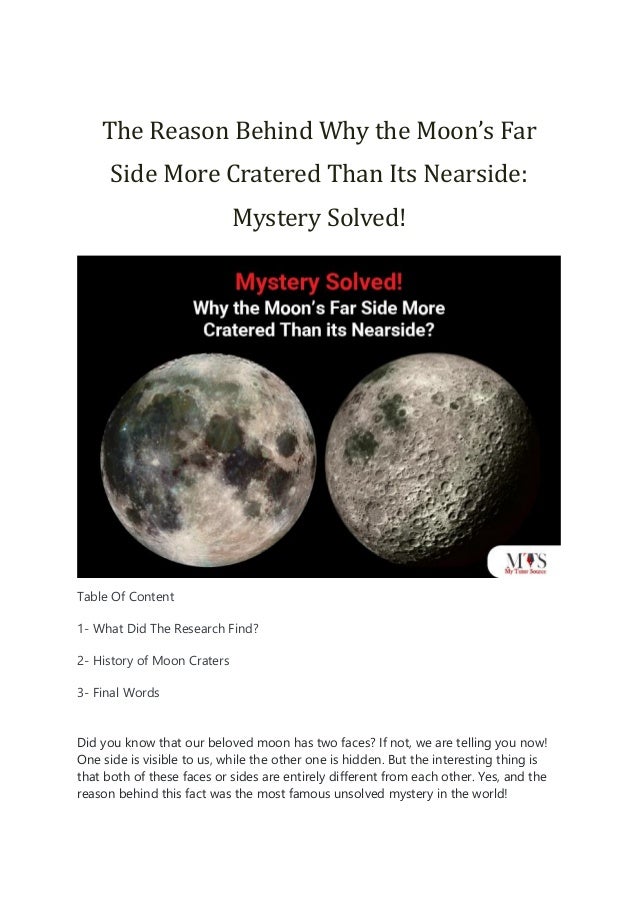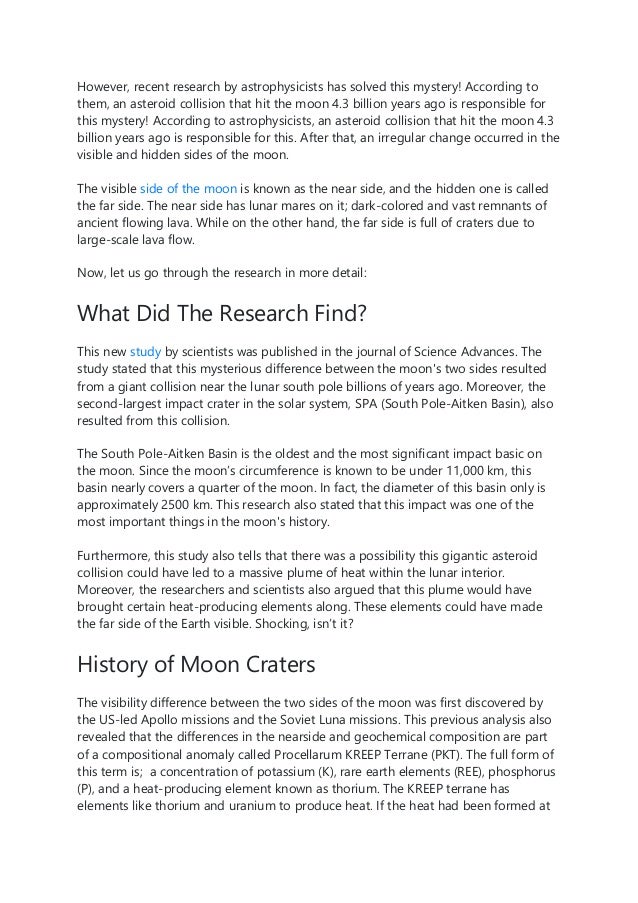The Reason Behind Why the Moon Far Side More Cratered Than its Nearside Mystery Solved.pdf
- 1. The Reason Behind Why the Moon’s Far Side More Cratered Than Its Nearside: Mystery Solved! Table Of Content 1- What Did The Research Find? 2- History of Moon Craters 3- Final Words Did you know that our beloved moon has two faces? If not, we are telling you now! One side is visible to us, while the other one is hidden. But the interesting thing is that both of these faces or sides are entirely different from each other. Yes, and the reason behind this fact was the most famous unsolved mystery in the world!
- 2. However, recent research by astrophysicists has solved this mystery! According to them, an asteroid collision that hit the moon 4.3 billion years ago is responsible for this mystery! According to astrophysicists, an asteroid collision that hit the moon 4.3 billion years ago is responsible for this. After that, an irregular change occurred in the visible and hidden sides of the moon. The visible side of the moon is known as the near side, and the hidden one is called the far side. The near side has lunar mares on it; dark-colored and vast remnants of ancient flowing lava. While on the other hand, the far side is full of craters due to large-scale lava flow. Now, let us go through the research in more detail: What Did The Research Find? This new study by scientists was published in the journal of Science Advances. The study stated that this mysterious difference between the moon's two sides resulted from a giant collision near the lunar south pole billions of years ago. Moreover, the second-largest impact crater in the solar system, SPA (South Pole-Aitken Basin), also resulted from this collision. The South Pole-Aitken Basin is the oldest and the most significant impact basic on the moon. Since the moon’s circumference is known to be under 11,000 km, this basin nearly covers a quarter of the moon. In fact, the diameter of this basin only is approximately 2500 km. This research also stated that this impact was one of the most important things in the moon's history. Furthermore, this study also tells that there was a possibility this gigantic asteroid collision could have led to a massive plume of heat within the lunar interior. Moreover, the researchers and scientists also argued that this plume would have brought certain heat-producing elements along. These elements could have made the far side of the Earth visible. Shocking, isn’t it? History of Moon Craters The visibility difference between the two sides of the moon was first discovered by the US-led Apollo missions and the Soviet Luna missions. This previous analysis also revealed that the differences in the nearside and geochemical composition are part of a compositional anomaly called Procellarum KREEP Terrane (PKT). The full form of this term is; a concentration of potassium (K), rare earth elements (REE), phosphorus (P), and a heat-producing element known as thorium. The KREEP terrane has elements like thorium and uranium to produce heat. If the heat had been formed at
- 3. that time, one part of the moon would have remained volcanic forever. However, that didn’t happen! The new and recent study, however, found that when the collision happened, major lava started flowing on the near side of the moon and filled all the impact craters. Here is what they stated: “What we show is that under any plausible conditions at the time that SPA formed, it ends up concentrating these heat-producing elements on the nearside. We expect that this contributed to the mantle melting that produced the lava flows we see on the surface,” Matt Jones said in an official release, adding, “And the South PoleAitken impact is one of the most significant events in lunar history. This work brings those two things together, and I think our results are really exciting.” Final Words So, now you know why the Moon’s far side is more cratered than the near side? Yes, because the collision filled almost all the craters from the near side!


